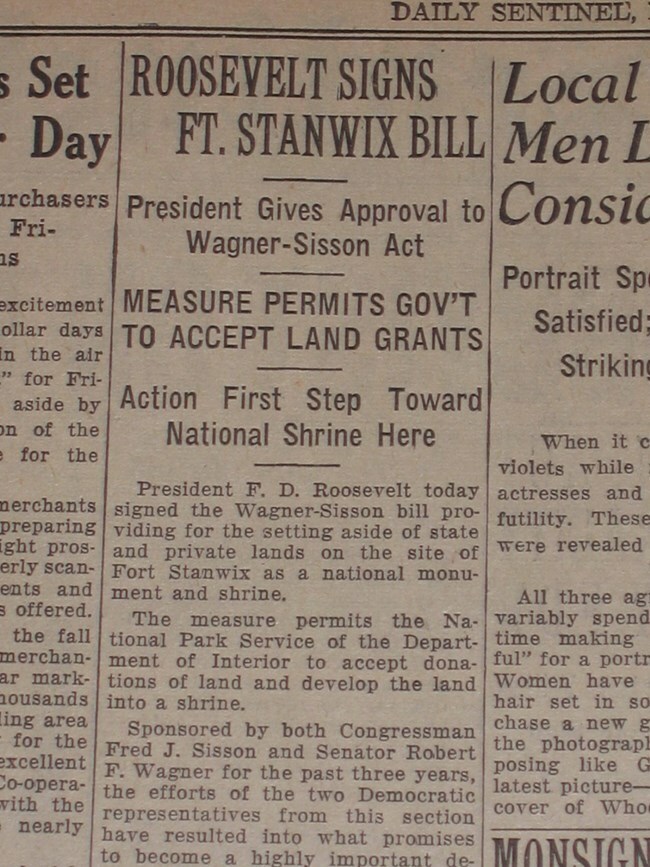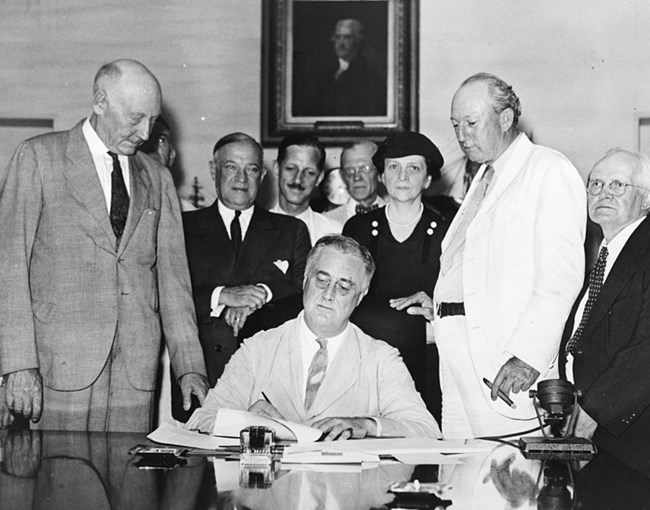Part of a series of articles titled The Momentous History of a Monument.
Article
75 Years - Thank You to The People who Refused to Forget: 1935-2010

Courtesy of The Rome Historical Society
During the French and Indian War, troops from Fort Stanwix launched successful attacks on Fort Frontenac in current Kingston, Ontario (1758), the forts at Oswego and Niagara (1759), and Montreal, Canada (1760). Although the number of troops was reduced after the war ended, Fort Stanwix remained garrisoned until the end of Pontiac’s Rebellion (1763 to 1766). The fort was abandoned as a military outpost; however, the site was utilized in 1768 for the Boundary Line Treaty of Fort Stanwix negotiations. This treaty drew a controversial boundary line between Colonial and American Indian land and extended from Fort Stanwix south and west to the confluence of the Tennessee and Ohio Rivers. This treaty opened lands that would eventually become parts of western Pennsylvania, Maryland, Virginia, and West Virginia, Kentucky, and northeast Tennessee.
In the spring of 1776, while members of the Continental Congress were drafting the Declaration of Independence, General George Washington was ordered to rebuild Fort Stanwix. Continental soldiers arrived and began rebuilding the fort renaming it Fort Schuyler. In August 1777, General Barry St. Leger, commanding about 800 British soldiers, and American Loyalists, Canadian, and German troops, as well as, about 800 American Indians, besieged the still incomplete Fort Schuyler for 21 days. The fort’s garrison of about 600 troops, including men of the 3rd New York regiment, 30 artillerymen from Connecticut, and recently arrived 200 soldiers from Massachusetts, refused to surrender. Not prepared for a lengthy siege, still reeling from the affects of the August 6th Battle of Oriskany, and being faced with the advance of Continental Soldiers commanded by General Benedict Arnold, St. Leger was forced retreat. St. Leger’s withdrawal, in association with the American victory at the Battle of Bennington and tactics employed by Continental forces to slow and harass the advance of the British army in the Lake Champlain and Hudson River Valley region, forced British General John Burgoyne and his troops to surrender after the Battles of Saratoga. Despite the Continental Army’s unsuccessful attempt to defeat the British around Philadelphia, Pennsylvania during the same period, the British defeat at Saratoga turned the tide of the American Revolution as it convinced France and the Netherlands to sign alliances with the American Continental Congress. Spain later entered the war as an ally of France. Thus American War for Independence was transformed into a world war. The Battles of Saratoga are considered by many historians to be the most significant battles in American history.
After the siege, Continental troops from Fort Stanwix continued to protect New York's frontier and participated in the 1779 Clinton-Sullivan Campaign. The fort was flooded in the spring of 1781 and burned later that year, resulting in the Continental Army to eventually abandon the fort altogether. Nevertheless, the site was used again by the United States, Pennsylvanians, and New Yorkers as a site to negotiate treaties and land transactions with American Indians in 1784, 1788 and 1790. These treaties and land transactions opened northern Pennsylvania, Ohio, Michigan, Indiana and Illinois for American settlement. Also, large areas of central and western New York were opened through which multiple canals, including the Erie Canal, were dug.

In Rome there are streets, parks and schools named after Fort Stanwix and its commanders. Also, there are several historic markers placed around the city to identify sites and events. The people built a replica of the fort and held a 150th commemoration of the siege. The people wrote books about the events. The people considered renaming the city Fort Stanwix. Many people in Rome have a special relationship with the Stars and Stripes. And, the people worked hard to establish Fort Stanwix as a national monument on August 21, 1935. Your refusal to forget ensures that people in the nation and around the world will not forget Fort Stanwix either. Fort Stanwix is not a footnote in American history.
Each month during this year leading up to the 75th anniversary, the staff at Fort Stanwix National Monument will write special articles about the People of Rome and your refusal to forget Fort Stanwix and how this paved the way to the establishment of the national monument. The following articles will appear on our website the first weeks and months of 2010 leading up to the 75th anniversary events on August 21st and 22nd. Afterward the 75th anniversary, the articles will focus on how the people continued to remember Fort Stanwix leading up to its reconstruction.
During this 75th anniversary year, the National Park Service says thank you to the people of Rome for not forgetting Fort Stanwix, and working hard to establish a national monument within their community for the inspiration and benefit of everyone.

Rome Historical Society
Last updated: October 10, 2024
